#lebanese version
Text
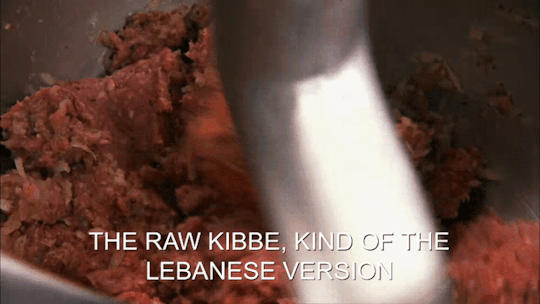
[THE RAW KIBBE, KIND OF THE LEBANESE VERSION]
#s05e06 something from everywhere#guy fieri#guyfieri#diners drive-ins and dives#the raw kibbe#lebanese version#kind
4 notes
·
View notes
Text


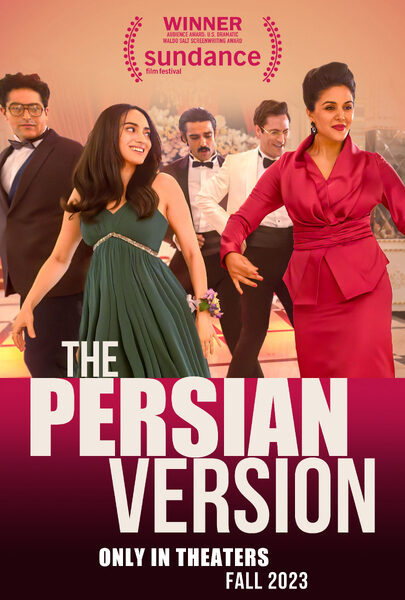


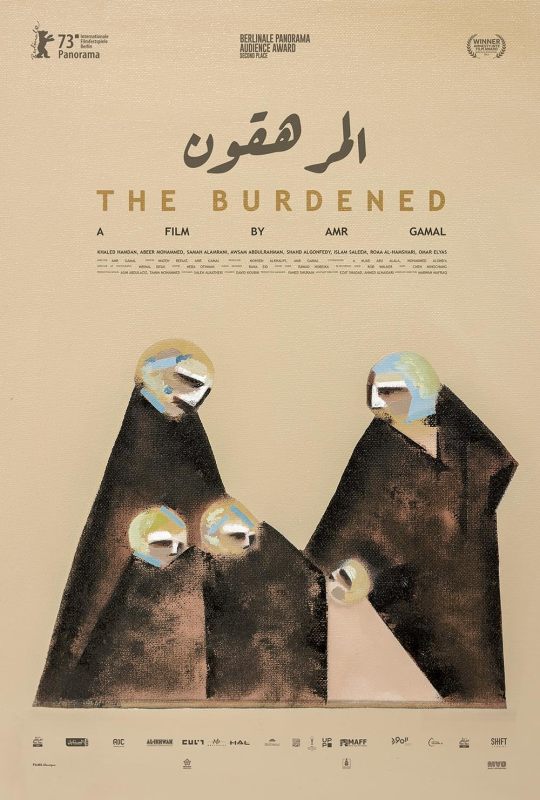
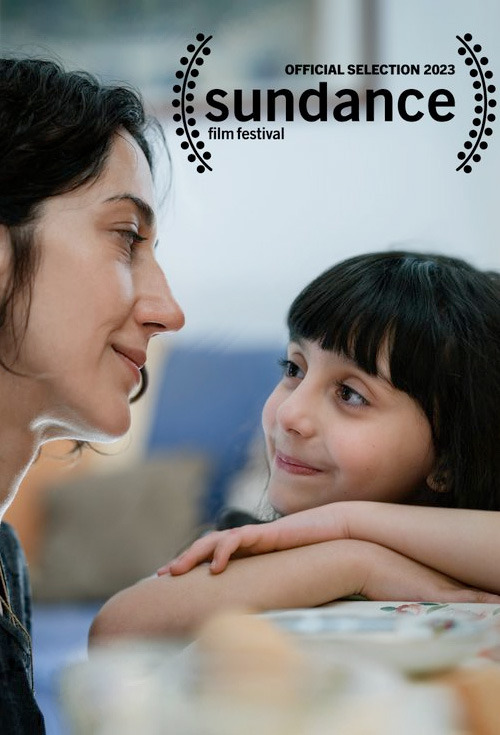


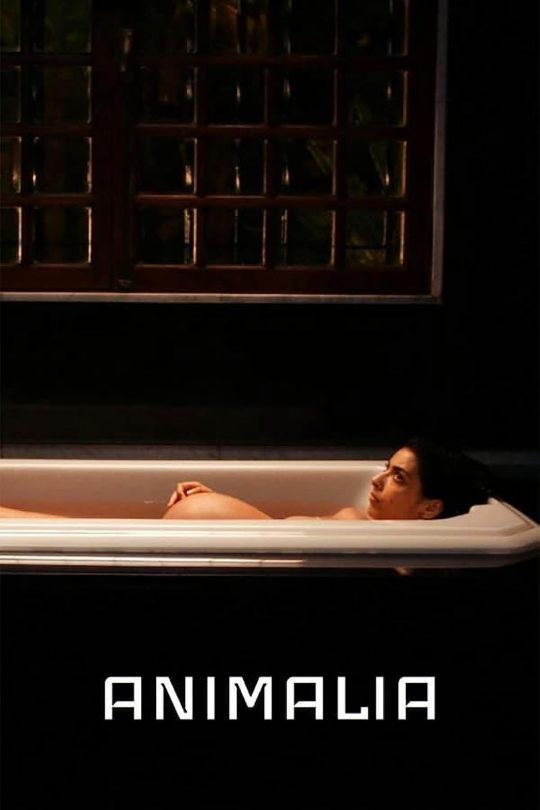
Some 2023-2024 Films from MENA/SWANA Filmmakers
The Mother of All Lies (2023). Dir. Asmae El Moudir
A Gaza Weekend (2023). Dir. Basil Khalil
The Persian Version (2023). Dir. Maryam Keshavarz
Challengers (2024). Dir. Luca Guadagnino
Goodbye Julia (2023). Dir. Mohamed Kordofani
The Burderned (2023). Dir. Amr Gamal
Shayda (2024). Dir. Noora Niasari
Exodus (2023). Dir. Abbe Hassan
Fremont (2023). Dir. Babak Jalali
Animalia (2023). Dir. Sofia Alaoui
#luca guadagnino#maryam keshavarz#challengers#the persian version#a gaza weekend#basil khalil#the mother of all lies#palestinain#Asmae El Moudir#algerian#fremont#Babak Jalali#afghan#abbe hassan#lebanese#exodus#animalia#Sofia Alaoui#saudi arabian#saudi#the burdened#yemeni#amr gamal#film#swana appreciation#mena appreciation
12 notes
·
View notes
Text
Thick-Style Lebanese Garlic Sauce

This sauce, using only garlic, salt, lemon juice, and oil, can be used as a condiment on grilled meats, as a salad dressing, and in dishes that require good garlic flavor.
1 note
·
View note
Photo
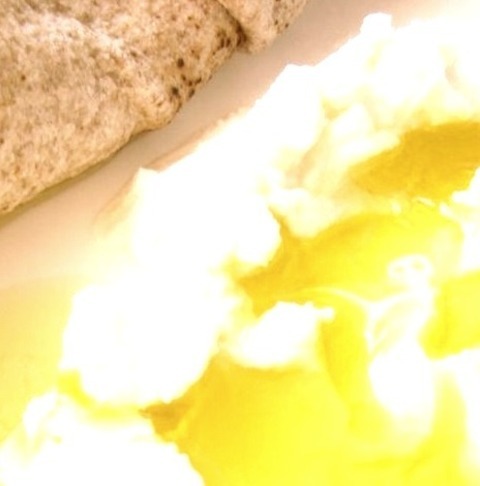
Labneh Lebanese Cream Cheese Recipe
This is the Lebanese version of cream cheese, a lot tastier and lower in calories. Serve on a plate, sprinkled with olive oil, olives, tomatoes, cucumbers and mint. Or simply spread it like cream cheese on pita bread. 1 teaspoon salt or to taste, 16 cups plain yogurt, 1/4 cup olive oil
0 notes
Photo
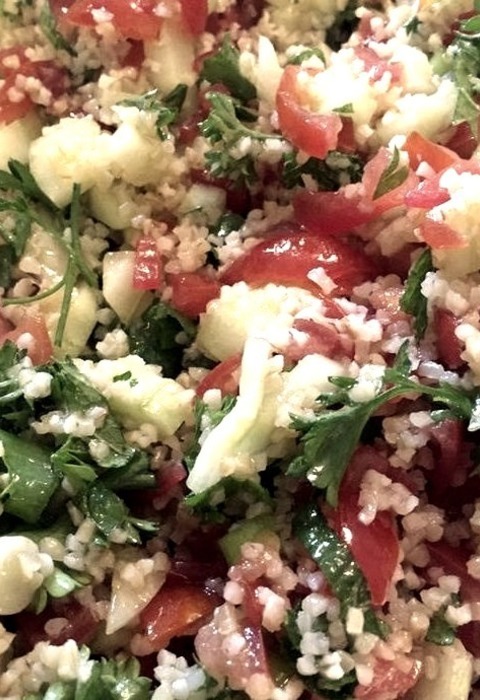
Tabbouleh III
This salad is light and flavorful and chock full of veggies that you can pull from your garden--tomatoes, cucumbers, and green onions. Add lots of parsley and mint and a nice splash of olive oil and lemon juice and that's it. Chill before serving to bring out the flavors. Serves eight.
0 notes
Photo

Instant Pot Lebanese Lentil and Chard Soup - Beans and Peas
#Make this classic Lebanese lentil and chard soup in an Instant Pot instead of on the stove--it's a bit easier and just as good. stews and ch#soups#chard#instant pot#stovetop version
0 notes
Text

[ID: A decorative orange ceramic plate with a pyramid of green herbs and sesame seeds, topped with deep red sumac and more sesame seeds. End ID]
زعتر فلسطيني / Za'tar falastinia (Palestinian spice blend)
Za'tar (زَعْتَر; also transliterated "za'atar," "zaatar" and "zatar") is the name of a family of culinary herbs; it is also the name of a group of spice blends made by mixing these herbs with varying amounts of olive oil, sumac, salt, roasted sesame seeds, and other spices. Palestinian versions of za'tar often include caraway, aniseed, and roasted wheat alongside generous portions of sumac and sesame seeds. The resulting blend is bold, zesty, and aromatic, with a hint of floral sourness from the sumac, and notes of licorice and anise.
Za'tar is considered by Palestinians to have particular national, political, and personal importance, and exists as a symbol of both Israeli oppression and Palestinian home-making and resistance. Its major components, olive oil and wild thyme, are targeted by the settler state in large part due to their importance to ecology, identity, and trade in Palestine—settlers burn and raze Palestinian farmers' olive trees by the thousands each year. A 1977 Israeli law forbade the harvesting of wild herbs within its claimed borders, with violators of the law risking fines and confiscation, injury, and even death from shootings or land mines; in 2006, za'tar was further restricted, such that even its possession in the West Bank was met with confiscation and fines.
Despite the blanket ban on harvesting wild herbs (none of which are endangered), Arabs are the only ones to be charged and fined for the crime. Samir Naamnih calls the ban an attempt to "starve us out," given that foraging is a major source of food for many Palestinians, and that picking and selling herbs is often the sole form of income for impoverished families. Meanwhile, Israeli farmers have domesticated and farmed za'tar on expropriated Palestinian land, selling it (both the herb and the spice mixture) back to Palestinians, and later marketing it abroad as an "Israeli" blend; they thus profit from the ban on wild harvesting of the herb. This farming model, as well as the double standard regarding harvesting, refer back to an idea that Arabs are a primitive people unfit to own the land, because they did not cultivate or develop it as the settlers did (i.e., did not attempt to recreate a European landscape or European models of agriculture); colonizing and settling the land are cast as justified, and even righteous.
The importance of the ban on foraging goes beyond the economic. Raya Ziada, founder of an acroecology nonprofit based in Ramallah, noted in 2019 that "taking away access to [wild herbs] doesn't just debilitate our economy and compromise what we eat. It's symbolic." Za'tar serves variously as a symbol of Palestinians' connection to the land and to nature; of Israeli colonial dispossession and theft; of the Palestinian home ("It’s a sign of a Palestinian home that has za’tar in it"); and of resistance to the colonial regime, as many Palestinians have continued to forage herbs such as za'tar and akkoub in the decades since the 1977 ban. Resistance to oppression will continue as long as there is oppression.
Palestine Action has called for bail fund donations to aid in their storming, occupying, shutting down, and dismantling of factories and offices owned by Israeli arms manufacturer Elbit Systems. Also contact your representatives in the USA, UK, and Canada.
Ingredients:
Za'tar (Origanum syriacum), 250g once dried (about 4 cups packed)
250g (1 2/3 cup) sesame seeds
170g (3/4 cup) Levantine sumac berries, or ground sumac (Rhus coriaria)
100g (1/2 cup) wheat berries (optional)
2 Tbsp olive oil
1 Tbsp aniseed (optional)
1/2 Tbsp caraway seeds (optional)
Levantine wild thyme (also known as Bible hyssop, Syrian oregano, and Lebanese oregano) may be purchased dried online. You may also be able to find some dried at a halal grocery store, where it will be labelled "زعتر" (za'tar) and "thym," "thyme," or "oregano." Check to make sure that what you're buying is just the herb and not the prepared mixture, which is also called "زعتر." Also ensure that what you're buying is not a product of Israel.
If you don't have access to Levantine thyme, Greek or Turkish oregano are good substitutes.
Wheat berries are the wheat kernel that is ground to produce flour. They may be available sold as "wheat berries" at a speciality health foods store. They may be omitted, or replaced with pre-ground whole wheat flour.
Instructions:
1. Harvest wild thyme and remove the stems from the leaves. Wash the leaves in a large bowl of water and pat dry; leave in a single layer in the sun for four days or so, until brittle. Skip this step if using pre-dried herbs.
2. Crumble leaves by rubbing them between the palms of your hands until they are very fine. Pass through a sieve or flour sifter into a large bowl, re-crumbling any leaves that are too coarse to get through.
Crumbling between the hands is an older method. You may also use a blender or food processor to grind the leaves.
3. Mix the sifted thyme with a drizzle of olive oil and work it between your hands until incorporated.
4. Briefly toast sumac berries, caraway seeds, and aniseed in a dry skillet over medium heat, then grind them to a fine powder in a mortar and pestle or a spice mill.
5. Toast sesame seeds in a dry skillet over medium heat, stirring constantly, until deeply golden brown.
6. (Optional) In a dry skillet on medium-low, toast wheat berries, stirring constantly, until they are deeply golden brown. Grind to a fine powder in a spice mill. If using ground flour, toast on low, stirring constantly, until browned.

Some people in the Levant bring their wheat to a local mill to be ground after toasting, as it produces a finer and more consistent texture.
7. Mix all ingredients together and work between your hands to incorporate.
Store za'tar in an airtight jar at room temperature. Mix with olive oil and use as a dipping sauce with bread.
2K notes
·
View notes
Text
Yasmin Porat, a survivor of the bloodshed at Kibbutz Be’eri, near the boundary with Gaza, says many Israeli civilians were killed by Israeli forces.
An Israeli woman who survived the Hamas assault on settlements near the Gaza boundary on 7 October says Israeli civilians were “undoubtedly” killed by their own security forces.
It happened when Israeli forces engaged in fierce gun battles with Palestinian fighters in Kibbutz Be’eri and fired indiscriminately at both the fighters and their Israeli prisoners.
“They eliminated everyone, including the hostages,” she told Israeli radio. “There was very, very heavy crossfire” and even tank shelling.
The woman, 44-year-old mother of three Yasmin Porat, said that prior to that, she and other civilians had been held by the Palestinians for several hours and treated “humanely.” She had fled the nearby “Nova” rave.
A recording of her interview, from the radio program Haboker Hazeh (“This Morning”) hosted by Aryeh Golan on state broadcaster Kan, has been circulating on social media.
Notably, the interview is not included in the online version of Haboker Hazeh for 15 October, the episode in which it apparently aired.
It may well have been censored due to its explosive nature.
Porat, who is from Kabri, a settlement near the Lebanese border, undoubtedly experienced terrible things and saw many noncombatants killed. Her own partner, Tal Katz, is among the dead.
However, her account undermines Israel’s official story of deliberate, wanton murder by the Palestinian fighters.
Although it no longer appears on the Kan website, there can be little doubt about the recording’s authenticity.
At least one Hebrew-language account posted part of the interview on Twitter, now officially called X, and accused Kan of functioning as “media in the service of Hamas.”
Porat also gave her account to the Israeli newspaper Maariv.
However, the Maariv story, published on 9 October, makes no specific mention of civilians being killed by Israeli forces.
And in a half-hour interview with Israel’s Channel 12 on Thursday, Porat speaks of intense gunfire after Israeli forces arrived. Porat herself received a bullet in the thigh.
Not only does Porat tell Kan that Israelis were killed in the heavy counterattack by Israeli security forces, but she says she and other captive civilians were well treated by the Palestinian fighters.
Porat had been attending the “Nova” rave when the Hamas assault began with missiles and motorized paragliders. She and her partner Tal Katz escaped by car to nearby Kibbutz Be’eri where many of the events she describes in her media interviews took place.
According to Porat speaking to Maariv, she and Katz initially sought refuge in the house of a couple called Adi and Hadas Dagan. After the Palestinian fighters found them they were all taken to another house, where eight people were already being held captive and one person was dead.
Porat said that the wife of the dead man “told us that when they [the Hamas fighters] tried to enter, the guy tried to prevent them from entering and grabbed the door. They shot at the door and he was killed. They did not execute them.”
“They did not abuse us. They treated us very humanely,” Porat explained to a surprised Golan in the Kan radio interview.
“By that I mean they guard us,” she said. “They give us something to drink here and there. When they see we are nervous they calm us down. It was very frightening but no one treated us violently. Luckily nothing happened to me like what I heard in the media.”
“They were very humane towards us,” Porat said in her Channel 12 interview. She recalled that one Palestinian fighter who spoke Hebrew, “told me, ‘Look at me well, were not going to kill you. We want to take you to Gaza. We are not going to kill you. So be calm, you’re not going to die.’ Thats what he told me, in those words.”
“I was calm because I knew nothing would happen to me,” she added.
“They told us that we would not die, that they wanted to take us to Gaza and that the next day they would return us to the border,” Porat told Maariv.
In the Channel 12 interview, Porat elaborates that although the Palestinian fighters all had loaded weapons, she never saw them shoot captives or threaten them with their guns.
In addition to providing the captives with drinking water, she said the fighters let them go outside to the lawn because it was hot, especially as the electricity was cut.
#journalism is dead#israel lies#israel is an apartheid state#israel is a terrorist state#jews against israel#ethnic cleansing#apartheid#gazaunderfire#gaza under attack#save palestine#stop killing children#stop israel#propaganda kills#genocide#palestinian lives matter#boycott israel#bds#israeli war crimes#friendly fire#icc war crimes tribunal
2K notes
·
View notes
Note
Do you know if pride flags are universal? Just wondering if any other countries use flags that have been created there. I'm guessing not because I think maybe we'd see them on Tumblr, but I also realize that lack of evidence on Tumblr doesn't make that a certainty☺️ anyway, I thought this blog would be a good place to ask. Also, I guess where were all the current standards designed?
Depending on what one thinks of in regard to pride flags (the progress flag, the rainbow flag, the asexual flag, etc.) they are fairly universally used. There is photographic evidence of them being used globally to represent queerness around the world!
That being said, there are customizations galore, both to represent individuality and intersectionality. This can mean similar colours but different configurations, additional elements added to flags, or multiple flags melded.
Flags in general usually start with an individual design from an individual person, such as the rainbow flag by Gilbert Baker. But localizing the rainbow design to represent a more specific intersection of identities is relatively common!
While researching, I found this great resource for localized versions of the rainbow flag and their individual uses and meanings: https://www.crwflags.com/fotw/flags/qq-rb_v.html
Here are some that I enjoyed learning about!
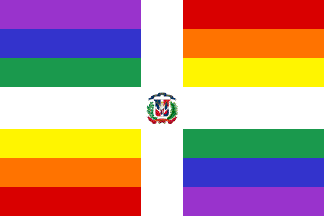
Dominican Republic gay pride

Hong Kong LGBT Flag
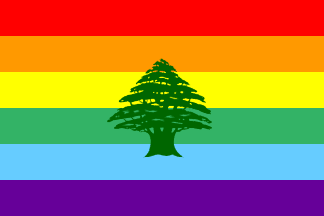
Lebanese gay flag (Lebanon)

LGBT Flag (South Korea)
I want to thank you for asking this because researching it was an enlightening experience for me! I enjoyed learning about it and am excited to share this information!
#queer history#queer#lgbt#lgbt history#gay history#answered#lesbian history#transgender history#transgender#making queer history#south korea#queer south korea#lebanon#queer lebanon#hong kong#queer hong kong#dominican republic#queer dominican republic
4K notes
·
View notes
Text

On his way to meet-up with his Grindr date. One thing Jeff likes about his life nowadays is the fact that he can swipe right to the most vile or even unattractive person, and with the premium paid version of the Chronivac seamlessly weaved into his Grindr, he can adjust that person to his liking. This seemed like a beta version that is not yet released to the public, or so he thought as he didn't even know to whom this phone actually belongs to. He just found it randomly in the club one night, tinkered a bit with it and then find the Grindr app looking a bit different from his usual one. That self-exploration lead him to find out about the built-in Chronivac, which he abused to sculpt himself into God's perfect image of a human being. He packed himself with muscle in all the right places, get rid of all the shortcomings like his poor eyesight, scoliosis, his partial color-blindness and all the small yet annoying sparse body acne to leave himself a nice, taut and smooth body. He increased his height substantially to 6'4" from his previous 5'6" form and rather than staying as a mixed Lebanese-Mexican man, he went on full Caucasian as he renamed himself as Dominic Groth, a German-Australian self-obsessed bodybuilding content creator. With such discovery, now he's excited to share this blessing to more people, of course with him as the one bestowing the transformation and the receiving end mostly unaware of the changes, at least for now
As he knocks on the door of his date, instead of a boring 5'7" fat fuck of a middle-aged accountant that clearly couldn't pull anyone, a towering 6'7" confident muscle beast answered the door

"Glad you ain't no catfish,"
"Same goes for you, Daddy,"
The massive guy smirked, his cock stirring in his pants after being called like that by a hulking 6'4" jock. Memories of his past life seemingly vanished into thin air as he grabbed Jeff into his house with such ease and confidence, as if this is just another day in the life of this bonafide muscle stud.
#male shapeshift#male transformation#chronivac#chronivac tf#male muscle growth#reality change#nerd to jock#nerd to hunk#fat to fit#oblivious
733 notes
·
View notes
Text
I'm Lebanese. I'm not Palestinian and will never know what it's like to be Palestinian and have never claimed otherwise. But I care so much because so many members of my extended family fled Lebanon to Australia when Israel invaded the south, and family I'll never meet died trying to fight them. I grew up with those stories, with a fraction of the pain I can only imagine Palestinians know. so I will, like my family, always stand in solidarity with Palestinians. because it's right. because, while I don't what it's like to be Palestinian, I know how monstrous Israel is. I know how they see us as animalistic faceless NPCs to mow down on the way to stealing homes and history and it must be stopped. My heart, broken as it is, is always with Palestinians enduring Israel's brutally. There is not and never will be a version of me who sympathises with a colonial state that murders and displaces families and ethnically cleanses for decades out of pure entitlement. Palestine should be free of Israeli occupation and every Israeli. Land back means land back!! Decolonisation means DECOLONISING!! If anyone who follows me has a problem with that then block me!!!
172 notes
·
View notes
Text
I heard a lot of things I wanted to share earlier today, but haven't reached a non-work computer until recently and was distracted by the airdrop news so I had to talk about that first. Most of the things that stood out to me were in the Democracy Now podcast, but I'll be linking the headlines from their website, which has text versions of the articles instead of just audio.
The Intercept: New York Times Exposé Lacks Evidence to Claim Hamas Weaponized Sexual Violence Oct. 7:
Shortly after the first Hamas attack, the New York Times published an inflammatory article about systematic rape by Hamas soldiers. It initially intended to have an episode of The Daily (its podcast) about the topic, but the podcast's fact-checkers found that the article's writers had bent a lot of truths and their sources were often questionable at best; the needed rewrites for honest reporting were so comprehensive that the episode script was scrapped entirely. Goes over the ways in which the reporters manipulated facts and opinions, the NYT not really acknowledging the conflict, and how heavily it impacted international response to Israeli actions, especially by the US government.
From their Headlines page, the bold is their titles and the reset is my summary or additional references:
Defense Sec. Austin Refuses to Draw Line in Sand for Israel After Food Aid Massacre in Gaza - DS Austin is grilled by a congressmember and still doesn't commit to anything; notable is that he cites a death toll that is probably accurate to the estimates of real death, but not accurate to the confirmed deaths and so the numbers had to be later walked back by the Pentagon.
Washington’s Largest Union Backs Democratic Vote for “Uncommitted” Ahead of Primary - UFCW is joining the movement that Michigan got rolling. I talked about it more in a recent addition to this post, if you want to know more about which states are organizing to do the same.
Lebanese PM Says Gaza Ceasefire Would End Conflict on Its Border with Israel - Lebanon has been bombing northern Israel for a while now; this is just the 'if you leave Palestine alone, we'll stop sending explosives your way' message that's been broadcast for a while.
There are a number of other stories going on that aren't getting a huge amount of coverage on most platforms, like Texas's wildfires, or are just too complex for me to summarize (they have a longer article on the border visit and policy debate), but these three stood out to me, which is probably why they're the first ones mentioned.
#united states#gaza#israel#palestine#lebanon#Lloyd Austin#death mention#phoenix politics#current events#ucfw#washington#Ro Khanna
47 notes
·
View notes
Note
mxdae tumblr com/post/747983797908275200/sabra-and-shatila-massacre-wikipedia#notes
Thoughts?
I can't open this link, but I've already made a post in the past about about the Sabra and Shatila massacre. Israel was never found directly responsible for the events,

-It is important to note that oftentimes the English Wikipedia versions of articles about Israeli history are either really biased \ lack information. I'd look for better sources TBH...
----
Israel wasn't responsible for this, it was done by Christian Lebanese terrorists targeting Muslim Palestinians refuges..
Even so, The head of IDF intelligence at the time issued several warnings beforehand and has fired army officials who failed in preventing the massacre. I'm not going to go into this furthermore as I've already made several posts about this in the past.
What I think of the massacre
Obviously I think it's a terrible massacre. However, I wasn't alive back then and I can't personally know what exactly happened during the massacre. I'd like to believe the truth is somewhere in the middle- maybe we took advantage of it to establish some sort of alliance later, I honestly couldn't know...
----
For further reading,I recommend you read about these topics as well:
-The Lebanese civil war.
-The Lebanon- Israel wars of 1982 and 2006.
-Religious conflicts in Lebanon between Christians and Muslims.
-Lebanese terror organisations.
I hope that this answers your questions, you're always welcome to ask more :)
#answered asks#israel#jewish#jewblr#טאמבלר ישראלי#gaza strip#ישראל#hamas is isis#israel palestine conflict#middle east#israeli#jumblr#jewish history#judaism#am yisrael chai
20 notes
·
View notes
Text
I was today years old when I found out that the core reason why Janice hated Regina was because she told her she was Lebanese, but Regina mistook It for lesbian and told the whole school....I really thought Janice was a lesbian this whole time and yet didn't question why she got with Kevin G at the end....
Yeah....today years old, y'all
Anyways, I'm glad she's actually a lesbian In the movie version of the musical (at least based on what I've seen)
#I never knew that that was the whole joke😭#I'm such a dumbass lmao#janice ian#regina george#mean girls#mean girls 2024
33 notes
·
View notes
Text


This was the first of my drawings of my Felicia redesign. I don't have a very complex or emotional history with her character, actually, I just found some pictures of her on Pinterest and I liked her immediately 😆
I started to feel an urge to recreate her in a way that was more personal, I really wanted to give her my personal touch. The first change I made was on her nose, then my imagination just went off wandering on its own, until I reached this result. In my rewriting, she is originally born with dark hair, her platinum locks are achieved later, after a particular event with one of my OCs... No spoilers 🫣
Her full name is Felicia Hernandez Hardy (Hadi), she is ethnically Latina (she is born in a mixed Brazilian, Argentinian and Uruguayan environment) from her mother's side and Arab (Lebanese) from her father's side. I just have a draft of the story and her background for now and some things might change, but I wanted to share my thought process behind her OCfied version ✌🏼
I hope you like her! ✨🐈⬛
•••
support me on: ko-fi || commissions
follow me on: instagram || tiktok

#felicia hardy#felicia hardy fanart#oc felicia#oc felicia hardy#felicia hernandez hardy#felicia hardy black cat#felicia hardy marvel#black cat fanart#black cat#black cat marvel#marvel fandom#marvel comics#ocfied canon characters#oc tag#nantosueltas ocs#nantosueltas
22 notes
·
View notes
Text
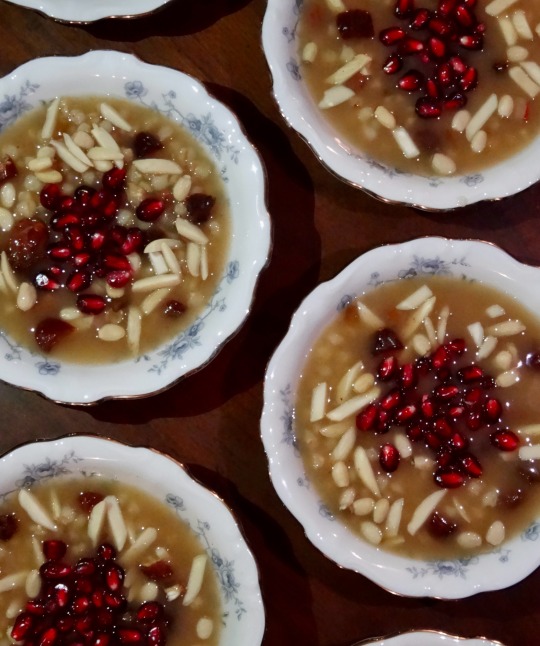
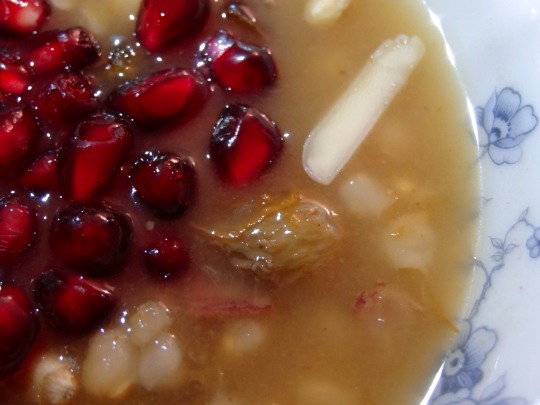
[ID: First image shows four small porcelain bowls of a pudding topped with slivered almonds and pomegranates seeds, seen from above. Second image is an extreme close-up showing the blue floral pattern on the china, slivered almonds, golden raisins, and pomegranate seeds on top of part of the pudding. End ID]
անուշապուր / Anush apur (Armenian wheat dessert)
Anush apur is a sweet boiled wheat pudding, enriched with nuts and dried fruits, that is eaten by Armenians to celebrate special occasions. One legend associates the dish with Noah's Ark: standing on Mt. Ararat (Արարատ լեռը) and seeing the rainbow of God's covenant with humanity, Noah wished to celebrate, and called for a stew to be prepared; because the Ark's stores were diminishing, the stew had to be made with small amounts of many different ingredients.
The consumption of boiled grains is of ancient origin throughout the Levant and elsewhere in West Asia, and so variations of this dish are widespread. The Armenian term is from "անուշ" ("anush") "sweet" + "ապուր" ("apur") "soup," but closely related dishes (or, arguably, versions of the same dish) have many different, overlapping names.
In Arabic, an enriched wheat pudding may be known as "سْنَينِيّة" ("snaynīyya"), presumably from "سِنّ" "sinn" "tooth" and related to the tradition of serving it on the occasion of an infant's teething; "قَمْح مَسْلُوق" ("qamḥ masluq"), "boiled wheat"; or "سَلِيقَة" ("salīqa") or "سَلِيقَة القَمْح" ("salīqa al-qamḥ"), "stew" or "wheat stew," from "سَلَقَ" "salaqa" "to boil." Though these dishes are often related to celebrations and happy occasions, in some places they retain an ancient association with death and funerary rites: qamh masluq is often served at funerals in the Christian town of بَيْت جَالَا ("bayt jālā," Beit Jala, near Bethlehem).
A Lebanese iteration, often made with milk rather than water, is known as "قَمْحِيَّة" ("qamḥīyya," from "qamḥ" "wheat" + "ـِيَّة" "iyya," noun suffix).
A similar dish is known as "بُرْبَارَة" ("burbāra") by Palestinian and Jordanian Christians when eaten to celebrate the feast of Saint Barbara, which falls on the 4th of December (compare Greek "βαρβάρα" "varvára"). It may be garnished with sugar-coated chickpeas and small, brightly colored fennel candies in addition to the expected dried fruits and nuts.
In Turkish it is "aşure," from the Arabic "عَاشُوْرَاء" ("'āshūrā"), itself from "عَاشِر" ("'āshir") "tenth"—because it is often served on the tenth day of the month of ٱلْمُحَرَّم ("muḥarram"), to commemorate Gabriel's teaching Adam and Eve how to farm wheat; Noah's disembarkment from the Ark; Moses' parting of the Red Sea; and the killing of the prophet الْحُسَيْن بْنِ عَلِي (Husayn ibn 'Ali), all of which took place on this day in the Islamic calendar. Here it also includes various types of beans and chickpeas. There is also "diş buğdayı," "tooth wheat" (compare "snayniyya").
These dishes, as well as slight variations in add-ins, have varying consistencies. At one extreme, koliva (Greek: "κόλλυβα"; Serbian: "Кољиво"; Bulgarian: "Кутя"; Romanian: "colivă"; Georgian: "კოლიო") is made from wheat that has been boiled and then strained to remove the boiling water; at the other, Armenian anush apur is usually made thin, and cools to a jelly-like consistency.
Anush apur is eaten to celebrate occasions including New Year's Eve, Easter, and Christmas. In Palestine, Christmas is celebrated by members of the Armenian Apostolic church from the evening of December 24th to the day of December 25th by the old Julian calendar (January 6th–7th, according to the new Gregorian calendar); Armenian Catholics celebrate on December 24th and 25th by the Gregorian calendar. Families will make large batches of anush apur and exchange bowls with their neighbors and friends.
The history of Armenians in Palestine is deeply interwoven with the history of Palestinian Christianity. Armenian Christian pilgrimages to holy sites in Palestine date back to the 4th century A.D., and permanent Armenian monastic communities have existed in Jerusalem since the 6th century. This enduring presence, bolstered by subsequent waves of immigration which have increased and changed the character of the Armenian population in Palestine in the intervening centuries, has produced a rich history of mutual influence between Armenian and Palestinian food cultures.
In the centuries following the establishment of the monasteries, communities of Armenian laypeople arose and grew, centered around Jerusalem's Վանք Հայոց Սրբոց Յակոբեանց ("vank hayots surbots yakobeants"; Monastery of St. James) (Arabic: دَيْر مَار يَعْقُوب "dayr mār ya'qūb"). Some of these laypeople were descended from the earlier pilgrims. By the end of the 11th century, what is now called the Armenian Quarter—an area covering about a sixth of the Old City of Jerusalem, to the southwest—had largely attained its present boundaries.
Throughout the 16th and 17th centuries, the Patriarchate in Jerusalem came to have direct administrative authority over Armenian Christians across Palestine, Lebanon, Egypt, and Cyprus, and was an important figure in Christian leadership and management of holy sites in Jerusalem (alongside the Greek Orthodox and Roman Catholic churches). By the middle of the 19th century, a small population of Armenian Catholics had joined the larger Armenian Apostolic community as permanent residents in Jerusalem, living throughout the Muslim Quarter (but mostly in a concentrated enclave in the southwest); in the beginning of the 20th century, there were between 2,000 and 3,000 Armenians of both churches in Palestine, a plurality of whom (1,200) lived in Jerusalem.
The Turkish genocide of Armenians beginning in 1915 caused significant increases in the populations of Armenian enclaves in Palestine. The Armenian population in Jerusalem grew from 1,500 to 5,000 between the years of 1918 and 1922; over the next 3 years, the total number of Armenians in Palestine (according to Patriarchate data) would grow to 15,000. More than 800 children were taken into Armenian orphanages in Jerusalem; students from the destroyed Չարխափան Սուրբ Աստվածածին վանք (Charkhapan Surb Astvatsatsin Monastery) and theological seminary in Armash, Armenia were brought to the Jerusalem Seminary. The population of Armenian Catholics in the Muslim Quarter also increased during the first half of the 20th century as immigrants from Cilicia and elsewhere arrived.
The immediate importance of feeding and housing the refugees despite a new lack of donations from Armenian pilgrims, who had stopped coming during WW1—as well as the fact that the established Armenian-Palestinians were now outnumbered by recent immigrants who largely did not share their reformist views—disrupted efforts on the part of lay communities and some priests to give Armenian laypeople a say in church governance.
The British Mandate, under which Britain assumed political and military control of Palestine from 1923–1948, would further decrease the Armenian lay community's voice in Jerusalem (removing, for example, their say in elections of new church Patriarchs). The British knew that the indigenous population would be easier to control if they were politically and socially divided into their separate religious groups and subjected to the authority of their various religious hierarchies, rather than having direct political representation in government; they also took advantage of the fact that the ecclesiastical orders of several Palestinian Christian sects (including the Armenian Patriarchate of Jerusalem) comprised people from outside of Palestine, who identified with religious hierarchy and the British authorities more than they identified with the Palestinian lay communities.
British policy, as well as alienating Armenians from politics affecting their communities, isolated them from Arab Palestinians. Though the previously extant Armenian community (called "քաղաքացի" "kaghakatsi," "city-dwellers") were thoroughly integrated with the Arab Palestinians in the 1920s, speaking Arabic and Arabic-accented Armenian and eating Palestinian foods, the newer arrivals (called "زُوَّار" / "զուվվար" "zuwwar," "visitors") were unfamiliar with Palestinian cuisine and customs, and spoke only Armenian and/or Turkish. Thus British policies, which differentiated people based on status as "Arab" (Muslim and Christian) versus "Jewish," left new Armenian immigrants, who did not identify as Arab, disconnected from the issues that concerned most Palestinians. They were predominantly interested in preserving Armenian culture, and more concerned with the politics of the Armenian diaspora than with local ones.
Despite these challenges, the Armenian Patriarchate of Jerusalem came to be a vital center of religious and secular culture for the Armenian diaspora during the British Mandate years. In 1929, Patriarch Yeghishe Turian reëstablished the Սուրբ Յակոբեանց Տպարան ("surbots yakobeants taparan"; St. James printing house); the Patriarchate housed important archives relating to the history of the Armenian people; pilgrimages of Armenians from Syria, Lebanon, and Egypt increased and the economy improved, attracting Armenian immigrants in higher numbers; Armenians held secular roles in governance, policing, and business, and founded social, religious, and educational organizations and institutions; Armenians in the Old and New Cities of Jerusalem were able to send financial aid to Armenian victims of a 1933 earthquake in Beirut, and to Armenians expelled in 1939 when Turkey annexed Alexandretta.
The situation would decline rapidly after the 1947 UN partition resolution gave Zionists tacit permission to expel Palestinians from broad swathes of Palestine. Jerusalem, intended by the plan to be a "corpus separatum" under international administration, was in fact subjected to a months-long war that ended with its being divided into western (Israeli) and eastern (Palestinian) sections. The Armenian population of Palestine began to decline; already, 1947 saw 1,500 Armenians resettled in Soviet Armenia. The Armenian populations in Yafa and Haifa would fall yet more significantly.
Still, the Armenian Patriarchate of Jerusalem maintained its role as the center of Armenian life in Palestine; the compound provided food and shelter to thousands of Armenians during the Battle for Jerusalem and the Nakba (which began in 1948). Some Armenians formed a militia to defend the Armenian Quarter against Haganah shelling during the battle.
In the following years, historical British contributions to the shoring up of insular power in the Patriarchate would cause new problems. The Armenian secular community, no longer empowered to oversee the internal workings of the Patriarchate, could do nothing to prevent embezzling, corruption, and even the sale of church-owned land and buildings to settlers.
In 1967, Israeli military forces annexed East Jerusalem, causing another, albeit smaller, surge in Armenian emigration from the city. Daphne Tsimhoni estimates based on various censuses that the Armenian population of Jerusalem, which had reached 5,000-7,000 at its peak in 1945–6, had fallen back to 1,200 by 1978.
Today, as in the 20th century, Armenians in Jerusalem (who made up nearly 90% of the Armenian population of Palestine as of 1972) are known for the insularity of their community, and for their skill at various crafts. Armenian food culture has been kept alive and well-defined by successive waves of immigrants. As of 2017, the Armenian Patriarchate supplied about 120 people a day with Armenian dishes, including Ղափամա / غاباما "ghapama" (pumpkin stuffed with rice and dried fruits), թոփիկ / توبيك "topig" (chickpea-and-potato dough stuffed with an onion, nut, fruit, and herb filling, often eaten during Lent), and Իչ / ايتش "eetch" (bulgur salad with tomatoes and herbs).
Restaurants lining the streets of the Armenian and Christian quarters serve a mixture of Armenian and Palestinian food. Լահմաջո "lahmadjoun" (meat-topped flatbread), and հարիսա / هريس "harisa" (stew with wheat and lamb) are served alongside ֆալաֆել / فلافل ("falafel") and մուսախան / مسخن ("musakhkhan"). One such restaurant, Taboon Wine Bar, was the site of a settler attack on Armenian diners in January 2023.
Up until 2023, despite fluctuations in population, the Armenian community in Jerusalem had been relatively stable when compared to other Armenian communities and to other quarters of the Old City; the Armenian Quarter had not been subjected to the development projects to which other quarters had been subjected. However, a deal which the Armenian Patriarchate had secretly and unilaterally made with Israel real estate developer Danny Rotham in 2021 to lease land and buildings (including family homes) in the Quarter led Jordan and Palestine to suspend their recognition of the Patriarch in May of 2023.
On 26th October, the Patriarchate announced that it was cancelling the leasing deal. Later the same day, Israeli bulldozers tore up pavement and part of a wall in حديقة البقر ("ḥadīqa al-baqar"; Cows' Garden; Armenian: "Կովերի այգու"), the planned site of a new luxury hotel. On 5th November, Rothman and other representatives of Xana Gardens arrived with 15 settlers—some of them with guns and attack dogs—and told local Armenians to leave. About 200 Armenian Palestinians arrived and forced the settlers to stand down.
On 12th and 13th November, the developer again arrived with bulldozers and attempted to continue demolition. In response, Armenian Palestinians have executed constant sit-ins, faced off against bulldozers, and set up barricades to prevent further destruction. The Israeli occupation police backed settlers on another incursion on 15th November, ordering Armenian residents to vacate the land and arresting three.
On December 28th, a group of Armenian bishops, priests, deacons, and seminary students (including Bishop Koryoun Baghdasaryan, the director of the Patriarchate's real estate department) were attacked by a group of more than 30 people armed with sticks and tear gas. The Patriarchate attributed this attack to Israeli real estate interests trying to intimidate the Patriarchate into abandoning their attempt to reverse the lease through the court system. Meanwhile, anti-Armenian hate crimes (including spitting on priests) had noticeably increased for the year of 2023.
These events in Palestine come immediately after the ethnic cleansing of Լեռնային Ղարաբաղ ("Lernayin Gharabagh"; Nagorno-Karabakh); Israel supplied exploding drones, long-range missiles, and rocket launchers to help Azerbaijan force nearly 120,000 Armenians out of the historically Armenian territory in September of 2023 (Azerbaijan receives about 70% of its weapons from Israel, and supplies about 40% of Israel's oil).
Support Palestinian resistance by donating to Palestine Action’s bail fund; buying an e-sim for distribution in Gaza; or donating to help a family leave Gaza.
Ingredients
180g (1 cup) pearled wheat (قمح مقشور / խոշոր ձաւար), soaked overnight
3 cups water
180-360g (a scant cup - 1 3/4 cup) sugar, or to taste
Honey or agave nectar (optional)
1 cup total diced dried apricots, prunes, golden raisins, dried figs
1 cup total chopped walnuts, almonds, pistachios
1 tsp rosewater (optional)
Ceylon cinnamon (դարչին) or cassia cinnamon (կասիա)
Aniseed (անիսոն) (optional)
Large pinch of salt
Pomegranate seeds, to top (optional)
A Palestinian version of this dish may add pine nuts and ground fennel.
Pearled wheat is whole wheat berry that has gone through a "pearling" process to remove the bran. It can be found sold as "pearled wheat" or "haleem wheat" in a halal grocery store, or a store specializing in South Asian produce.
Amounts of sugar called for in Armenian recipes range from none (honey is stirred into the dish after cooking) to twice the amount of wheat by weight. If you want to add less sugar than is called for here, cook down to a thicker consistency than called for (as the sugar will not be able to thicken the pudding as much).
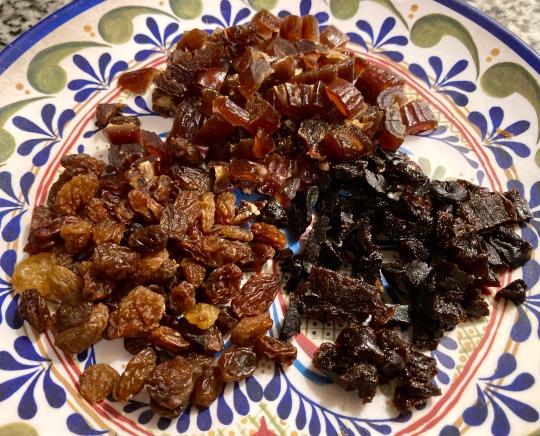
Instructions
1. Submerge wheat in water and scrub between your hands to clean and remove excess starch. Drain and cover by a couple inches with hot water. Cover and leave overnight.
2. Drain wheat and add to a large pot. Add water to cover and simmer for about 30 minutes until softened, stirring and adding more hot water as necessary.

Wheat before cooking
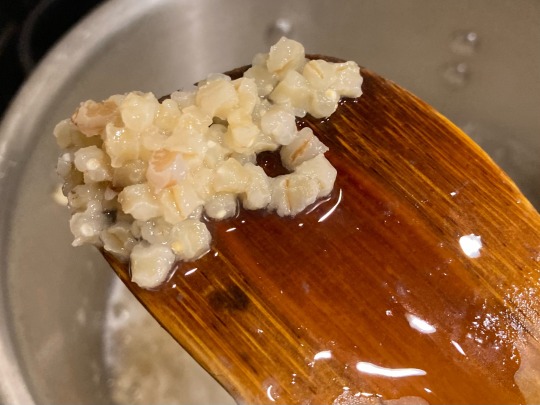
Wheat after cooking
3. Add dried fruit, sugar, salt, and spices and simmer for another 30 minutes, stirring occasionally, until wheat is very tender. Add water as necessary; the pudding should be relatively thin, but still able to coat the back of a spoon.
4. Remove from heat and stir in rosewater and honey. Ladle pudding into individual serving bowls and let cool in the refrigerator. Serve cold decorated with nuts and pomegranate seeds.
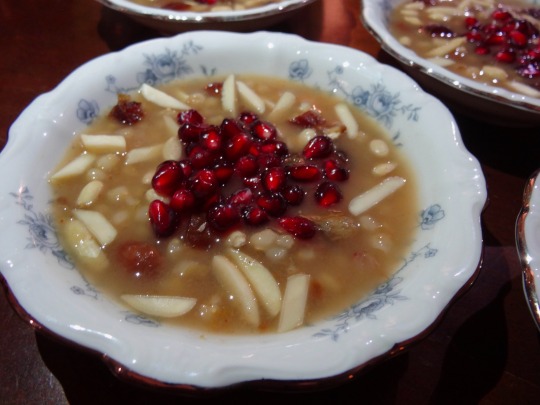
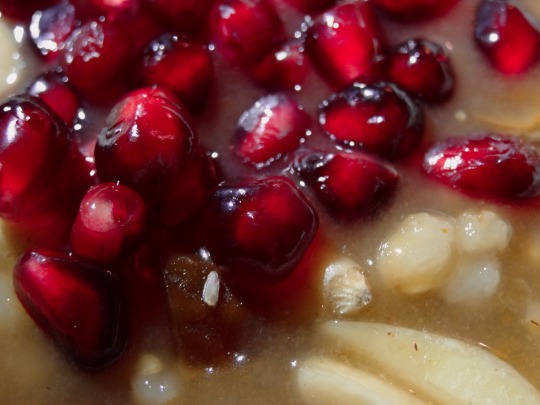
#the last link is a different / new fundraiser#Armenian#Palestinian#fusion#wheat berries#pearled wheats#pomegranate#prunes#dried apricot#dates#long post /
364 notes
·
View notes